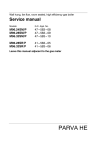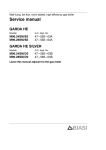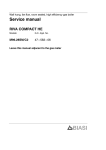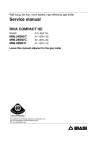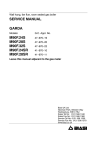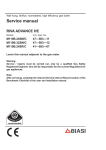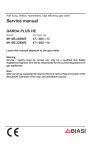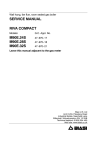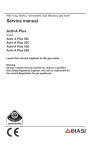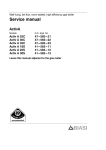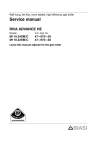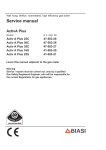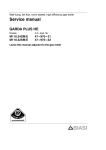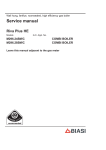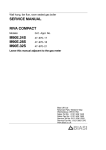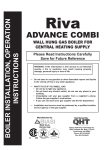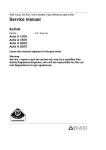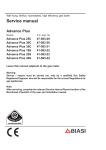Download Service manual
Transcript
Wall hung, fan flue, room sealed, high efficiency gas boiler Service manual GARDA HE MK2 Models: G.C. Appl. No. M96A.24SM/B M96A.28SM/B 47---583---15 47---583---16 Combi boiler Combi boiler Leave this manual adjacent to the gas meter Table of contents 11 11.1 11.2 11.3 11.4 11.5 11.6 Modulating gas valve . . . . . . . . . . . . . . . . Function . . . . . . . . . . . . . . . . . . . . . . . . . . . . . Nomenclature of the parts . . . . . . . . . . . . . Adjustment . . . . . . . . . . . . . . . . . . . . . . . . . . Checks . . . . . . . . . . . . . . . . . . . . . . . . . . . . . Removal of the on---off operators coils . . Removal of the gas valve . . . . . . . . . . . . . . 27 27 27 27 28 28 28 12 12.1 12.2 12.3 Primary circuit pressure switch . . . . . . . Function . . . . . . . . . . . . . . . . . . . . . . . . . . . . . Checks . . . . . . . . . . . . . . . . . . . . . . . . . . . . . Removal . . . . . . . . . . . . . . . . . . . . . . . . . . . . 29 29 29 29 13 Expansion vessel and temperature-- pressure gauge . . . . . . . . Function . . . . . . . . . . . . . . . . . . . . . . . . . . . . . Checks . . . . . . . . . . . . . . . . . . . . . . . . . . . . . Removal of the expansion vessel . . . . . . . Removal of the temperature---pressure gauge . . . . . . . . . . . . . . . . . . . . . . . . . . . . . . . 1 1.1 1.2 Overall information . . . . . . . . . . . . . . . . . . Overall View . . . . . . . . . . . . . . . . . . . . . . . . . Hydraulic diagram . . . . . . . . . . . . . . . . . . . . 1 1 1 2 2.1 2.2 2.3 2.4 2.5 2.6 General access and emptying hydraulic circuits . . . . . . . . . . . . . . . . . . . . Nomenclature . . . . . . . . . . . . . . . . . . . . . . . . Body panels . . . . . . . . . . . . . . . . . . . . . . . . . Control panel . . . . . . . . . . . . . . . . . . . . . . . . Access to the sealed chamber . . . . . . . . . Emptying the primary circuit . . . . . . . . . . . Emptying the d.h.w. circuit . . . . . . . . . . . . 2 2 2 2 3 3 3 3 3.1 3.2 3.3 Diagrams . . . . . . . . . . . . . . . . . . . . . . . . . . . Wiring diagram . . . . . . . . . . . . . . . . . . . . . . . Functional flow diagrams . . . . . . . . . . . . . . Circuit voltages . . . . . . . . . . . . . . . . . . . . . . 4 4 5 6 13.1 13.2 13.3 13.4 4 Fault finding . . . . . . . . . . . . . . . . . . . . . . . . 7 5 5.1 5.2 5.3 Primary heat exchanger . . . . . . . . . . . . . . Function . . . . . . . . . . . . . . . . . . . . . . . . . . . . . Removal . . . . . . . . . . . . . . . . . . . . . . . . . . . . Cleaning . . . . . . . . . . . . . . . . . . . . . . . . . . . . 9 9 9 9 6 6.1 6.2 6.3 Condensing heat exchanger . . . . . . . . . . Function . . . . . . . . . . . . . . . . . . . . . . . . . . . . . Removal . . . . . . . . . . . . . . . . . . . . . . . . . . . . Cleaning . . . . . . . . . . . . . . . . . . . . . . . . . . . . 11 11 11 11 14 14.1 14.2 14.3 14.4 14.5 7 7.1 7.2 D.h.w. heat exchanger . . . . . . . . . . . . . . . 13 Function . . . . . . . . . . . . . . . . . . . . . . . . . . . . . 13 Removal . . . . . . . . . . . . . . . . . . . . . . . . . . . . 13 8 8.1 8.2 8.3 Pump . . . . . . . . . . . . . . . . . . . . . . . . . . . . . . . Function . . . . . . . . . . . . . . . . . . . . . . . . . . . . . Checks . . . . . . . . . . . . . . . . . . . . . . . . . . . . . Removal . . . . . . . . . . . . . . . . . . . . . . . . . . . . 14 14 14 14 9 9.1 9.2 9.3 9.4 9.5 Three way diverter valve . . . . . . . . . . . . . Function . . . . . . . . . . . . . . . . . . . . . . . . . . . . . Checks . . . . . . . . . . . . . . . . . . . . . . . . . . . . . Removal of the electric actuator . . . . . . . . Removal of the tree way diverter valve . . Removal of the diverter group . . . . . . . . . . 16 16 16 16 17 17 Electronic control/ignition p.c.b. . . . . . . Function . . . . . . . . . . . . . . . . . . . . . . . . . . . . . Selection and adjustment devices . . . . . . Checking the temperature . . . . . . . . . . . . . Operation lights . . . . . . . . . . . . . . . . . . . . . . Setting the boiler control function modes Useful output setting . . . . . . . . . . . . . . . . . . Reignition frequency setting . . . . . . . . . . . Ignition gas pressure adjustment . . . . . . . Setting the tree way diverter valve operation mode . . . . . . . . . . . . . . . . . . . . . . 10.10 Checks . . . . . . . . . . . . . . . . . . . . . . . . . . . . . 10.11 Removal of the electronic control p.c.b . . 10.12 Thermal control in the ” ” mode . . . . . . 18 18 18 19 20 21 21 22 22 10 10.1 10.2 10.3 10.4 10.5 10.6 10.7 10.8 10.9 23 23 24 25 10.13 Thermal control in the ” ” mode . . . . . . 25 10.14 Ignition and control sequence . . . . . . . . . . 26 29 29 29 30 30 31 31 31 31 31 14.6 D.h.w. flow switch, filter and flow limiter Function . . . . . . . . . . . . . . . . . . . . . . . . . . . . . Nomenclature and location of parts . . . . . Checks . . . . . . . . . . . . . . . . . . . . . . . . . . . . . Removal of the sensor . . . . . . . . . . . . . . . . Removal of the flow switch group and d.h.w. circuit filter . . . . . . . . . . . . . . . . . Flow limiter . . . . . . . . . . . . . . . . . . . . . . . . . . 15 15.1 15.2 15.3 15.4 Temperature probe . . . . . . . . . . . . . . . . . . Function . . . . . . . . . . . . . . . . . . . . . . . . . . . . . Checks . . . . . . . . . . . . . . . . . . . . . . . . . . . . . Removal of the c.h. Temperature probe . Removal of the d.h.w.Temperature probe 33 33 33 33 33 16 16.1 16.2 By -- pass valve . . . . . . . . . . . . . . . . . . . . . . 35 Function . . . . . . . . . . . . . . . . . . . . . . . . . . . . . 35 Removal . . . . . . . . . . . . . . . . . . . . . . . . . . . . 35 17 17.1 17.2 17.3 17.4 Fan and Air pressure sensor . . . . . . . . . Function . . . . . . . . . . . . . . . . . . . . . . . . . . . . . Checks . . . . . . . . . . . . . . . . . . . . . . . . . . . . . Removal of the Fan . . . . . . . . . . . . . . . . . . . Removal of the Air pressure sensor . . . . . 36 36 36 37 37 18 18.1 18.2 18.3 Ignition and detection electrodes . . . . . Function . . . . . . . . . . . . . . . . . . . . . . . . . . . . . Checks . . . . . . . . . . . . . . . . . . . . . . . . . . . . . Removal . . . . . . . . . . . . . . . . . . . . . . . . . . . . 38 38 38 38 19 19.1 19.2 19.3 Safety thermostat . . . . . . . . . . . . . . . . . . . Function . . . . . . . . . . . . . . . . . . . . . . . . . . . . . Checks . . . . . . . . . . . . . . . . . . . . . . . . . . . . . Removal . . . . . . . . . . . . . . . . . . . . . . . . . . . . 39 39 39 39 20 20.1 20.2 20.3 Flue temperature probe NTC . . . . . . . . . Function . . . . . . . . . . . . . . . . . . . . . . . . . . . . . Checks . . . . . . . . . . . . . . . . . . . . . . . . . . . . . Removal . . . . . . . . . . . . . . . . . . . . . . . . . . . . 40 40 40 40 21 21.1 21.2 Condensate trap . . . . . . . . . . . . . . . . . . . . 42 Function . . . . . . . . . . . . . . . . . . . . . . . . . . . . . 42 Removal . . . . . . . . . . . . . . . . . . . . . . . . . . . . 42 22 Short spare parts list . . . . . . . . . . . . . . . . 44 31 32 1 Overall information 1.1 Overall View Flue temperature probe NTC Air pressure sensor Condensing heat exchanger Fan Expansion vessel Main heat exchanger Safety thermostat Combustion chamber C.h. temp. probe Burner Ignition electrodes Detection electrode Automatic air release valve Primary circuit pressure switch D.h.w. heat exchanger Diverter valve Condensate trap D.h.w. temp. probe Gas valve Pump Control panel 1.2 Hydraulic diagram Central heating (c.h.) operation C.h. water return C.h. water flow Domestic hot water (d.h.w.) operation D.h.w. inlet D.h.w. outlet 1 2 General access and emptying hydraulic circuits A 2.1 Nomenclature 1 2 6 Fig. 2 3 To remove the side panels loosen the screws B and C (Fig. 3), bring the base of the panels away from the boiler and lift them, freeing them from the top hooks. D 5 4 Fig. 1 1 Right side panel 2 Front panel 3 Control panel lid 4 Control panel cover 5 Service panel 6 Left side panel B C Fig. 3 --- bottom view of the boiler 2.3 2.2 Body panels Warning: isolate the boiler from the mains electricity supply before removing any covering or component. For the most part of the check and maintenance operations it is necessary to remove one or more panels of the case. The side panels can be removed only after the removal of the front panel. To remove the front panel remove screws A (Fig. 2), lift the panel and remove it. 2 Control panel Warning: isolate the boiler from the mains electricity supply before removing any covering or component. To gain access to the parts located inside the control panel proceed as follows: 1 Remove the front panel of the case 2 Loosen the screws B and C (Fig. 3). 3 Remove the screws D 4 Move the lower part of the side panels as indicated in Fig. 4 and pull the control panel. When completely pulled out, the panel can rotate 45˚ downwards to facilitate the service operations on the internal parts. General access and emptying hydraulic circuits To gain access to the parts contained in the sealed chamber it is necessary to remove the lid of the sealed chamber. For this purpose, remove the front and side panels of the case, remove the screws G as indicated in Fig. 6 and remove the lid. 2.5 1 Fig. 4 Emptying the primary circuit Close the c.h. circuit flow and return cocks H. (Fig. 7). Remove the screws E and remove the service panel (Fig. 5); To gain access to the electronic regulation PCB remove the screws F and remove the control panel lid (Fig. 5); 5 6 J H F E H Fig. 7 --- bottom view of the boiler F 2 Remove the front and right panels of the boiler. 3 Open the drain tap I (Fig. 8) until the boiler is completely emptied. 4 Close drain tap again once the emptying has been completed. Fig. 5 2.4 Access to the sealed chamber G I G Fig. 8 2.6 Fig. 6 Emptying the d.h.w. circuit 5 Close the d.c.w. inlet cock J (Fig. 7); 6 Open one or more hot water taps until the boiler has been completely emptied. 3 Diagrams 3.1 Wiring diagram Electric supply External controls terminal block terminal block L N Three way Pump diverter valve 1 3 2 1 bn gnye bu 2 M ~ rd bk wh Fan M ~ 3 Ignition electrodes Primary circuit pressure switch M ~ 3 bn bu gnye bu bn gnye Flame detection electrode Air pressure sensor 1 rd bk ye P bk gy 2 bu bk bn 3 bn bn bu bk bu *bk *bn *bu wh rd bk bn bu bn bu gnye gy gy bn bu rd rd ye gy wh bu bn bu bu bk bk bu bu bk bk rd rd gy ye wh wh bu bu rd gn wh bk rd 1 gy ye bu rd bu t rd wh D.h.w. temperature probe NTC * = alternative bn = brown bu = blue bk = black wh = white rd = red gy = grey gn = green ye = yellow vt = violet og = orange gnye = green/yellow 4 D.h.w. flow switch bn bu gnye bk wh bu bk t 3 4 Safety Modulating gas valve thermostat t bu wh Flue C.h. temperature probe NTC probe NTC rd bk wh gn Time switch Diagrams 3.2 Functional flow diagrams General layout J1--- 1 Fuse 3,15 A Electronic control p.c.b. (low voltage section) PTC Transformer L J3--- 5 J3--- 4 J3--- 3 Three way diverter valve J1--- 2 N Pump J3--- 1 J3--- 2 J2--- 5 J2--- 4 Full sequence ignition device Heat request on d.h.w. Electronic control p.c.b. (low voltage section) J1--- 1 Fuse 3,15 A PTC Transformer L J3--- 5 J3--- 4 J3--- 3 Three way diverter valve J1--- 2 N Pump L --- LINE J3--- 1 J3--- 2 J2--- 5 J2--- 4 N --- NEUTRAL ACTIVE CIRCUIT INACTIVE CIRCUIT Full sequence ignition device Heat request on c.h. Electronic control p.c.b. (low voltage section) J1--- 1 Fuse 3,15 A PTC Transformer L J3--- 5 J3--- 4 J3--- 3 Three way diverter valve J1--- 2 N Pump J3--- 1 J3--- 2 J2--- 5 J2--- 4 Full sequence ignition device 5 Diagrams 3.3 Circuit voltages during c.h. or d.h.w. operation only during c.h. operation Electrical voltages with burner on only during d.h.w. operation Pump 3 way diverter valve 230~ Supply network Fan 230~ Safety thermostat 6 0,5 ± 4,5 V DC +12 V DC 0 230~ 230~ 0 0 230~ 230~ Modulating Gas valve Air pressure sensor 7 J J J By pressing the reset push--- button the boiler starts the ignition cycle. The burner lights on, the ignition sparks continue and the boiler locks again. The boiler does not start either in c/h or d.h.w. mode. All the operation lights OFF Fan still. Flue pipes D.h.w. heat exchanger Diverter valve D.h.w. circuit C.h. circuit J 10.10 J J J J J J 9.2 D.h.w. flow switch The boiler lights for a short while on c.h. Normal operation on d.h.w. function. J 8.2 Pump 7 Fuses (Electronic p.c.b.) J J J --(4) Electronic p.c.b. The boiler doesn’t control the d.h.w. temperature. Turning the d.h.w. temp. adjustment knob hasn’t effect on the modulation of the flame. The boiler operates correctly on c.h. The burner doesn’t light either in c.h. or d.h.w. mode. Fan doesn’t turn. The burner doesn’t light either in c.h. or d.h.w. mode. Fan turns. J By pressing the reset push--- button the boiler starts the ignition cycle. The burner doesn’t light on, the ignition sparks continue and the boiler locks again. Power supply line J --(2) Gas supply line By pressing the reset push--- button the boiler turns on and operates correctly. Defect # --- 21.1 (3) Condensate drain pipe and trap --(1) Gas valve (on--- off operators) J Gas valve (modulating operator) J (6) Main circuit pressure switch J 15.2 Main circuit temp. probe J J D.h.w. temp. probe J J 16 By--- pass valve J 17.2 Fan J J Air pressure sensor J J 18.2 Ignition electrode J J J Detection electrode D.h.w. filter 12.2 14.5 19.2 20.1 J J Safety thermostat 11.4 J Flue probe NTC Section of the manual ! (note ref. in brackets) J J --(8) --(7) Injectors Components to check Expansion vessel Fault finding --- --- Safety valve 4 Lock--- out signal lamp red ON OFF Pressure gauge Boiler settings Power supply line Water leaks from the safety valve when the boiler is off. --- --- Poor d.h.w. temperature The boiler operates correctly but the gas pressure to the burner remains at minimum. Noisy bolier Incorrect modulation Water leaks from the safety valve during operation on c/h 2 Check for 230V~ between line (L) and neutral (N) Verify the integrity of supply cable, plug and external fuses. Check the polarity of line and neutral connection Verify the tightness of the gas supply pipe, the position of stop valves. Useful information can be obtained also from the optical indication given by the appliance operation lights (see section 10.4). 1 C.h. circuit J J D.h.w. flow switch J 10.10 Electronic p.c.b. J J J J Boiler settings J Gas valve (modulating operator) J J J J (9) J Gas valve (on--- off operators) Fuses (Electronic p.c.b.) Check for soundness and absence of obstructions. Verify that the flue terminal is correctly installed (see clearances) and ensure that exhaust gas is not sucked back by the boiler. Check for soundness of the circuit and verify its correct filling (see also installation manual). 4 15.2 Main circuit temp. probe 9 7 8 6 5 16 17.2 Fan 19.2 20.1 --(7) Injectors J J --(8) Expansion vessel Ignition electrode Air pressure sensor By--- pass valve D.h.w. temp. probe J J J J --- --- A jammed by--- pass could cause the over--- heating of the main circuit and the intervention of the safety thermostat. Check the minimum gas pressure at the outlet test point of the gas valve (see sect. 11.3) and compare it with the value given on the installation booklet. Verify the cleanness of injectors. Check the pressurization of the expansion vessel. Refer to the installation manual for proper values. d.h.w. pressure too high or flow rate too high. If necessary insert a flow rate limiter (14.6) J 18.2 Detection electrode 12.2 14.5 Safety thermostat 11.4 Safety valve Components to check Main circuit pressure switch Check the gas pressure at the inlet test point of the gas valve (see sect. 11.3) with the boiler at rest and during operation and compare it with the values given on the installation booklet. J J 9.2 D.h.w. filter 3 J D.h.w. circuit J 8.2 7 D.h.w. heat exchanger On c/h mode the temperature of the main circuit reaches 75°C and the c/h system does not heat. The boiler operates correctly on d.h.w. mode. Flue pipes J --(4) Pump J Low d.h.w. flow rate Note Gas supply line J --(2) Diverter valve The boiler does not supply d.h.w. (cold water from the tap). Regular operation in c/h mode even during a drawing off d.h.w. Defect # --- 21.1 (3) Condensate drain pipe and trap --(1) Flue probe NTC Section of the manual ! (note ref. in brackets) Lock--- out signal lamp red OFF F Pressure gauge 8 5 Primary heat exchanger 5.1 Function Remove the clip I and the safety thermostat J and the c.h. temperature probe K. It is not necessary to disconnect it from the wiring. 7 The primary heat exchanger A in Fig. 1 has the function of transferring heat produced from combustion of the gas to the water circulating in it. F H A N G P C J B I K M C E Fig. 1 The hydraulic circuit is composed of 8 elliptical pipes connected in parallel (Fig. 2). D L O Fig. 3 Loosen the connection L and move the pipe M downwards freeing it from the connection of the primary het exchanger. 9 Remove the clip N 10 Loosen the connection O 11 free the pipe P from the connection of the condensing heat exchanger; lift and and rotate it towards right. 12 Remove the heat exchanger by sliding it forwards. 13 Reassemble the boiler carrying out the removal operations in reverse order. Fit the clip I with the arrow pointing upwards as illustrated in Fig. 3. IMPORTANT -- do not force the connection G when tighting it. 8 Fig. 2 5.2 Removal Warning: isolate the boiler from the mains electricity supply before removing any covering or component. 1 2 3 4 5 6 Remove the case panels and the sealed chamber lid (see section 2). Empty the primary circuit of the boiler. Remove the combustion chamber lid B by unscrewing the screws C (Fig. 3). Remove the screws D and the plate E. Remove the clip F Loosen the connection G and slightly move the pipe H upwards. 5.3 Cleaning If there are deposits of soot or dirt between the blades of the heat exchanger, clean with a brush or non---metallic bristle brush. 9 Primary heat exchanger In any case, avoid any actions that can damage the protective varnish with which the exchanger has been covered. Warning: After cleaning or replacement as detailed above, if it deemed necessary to undertake a combustion analysis, refer to the appropriate chapter Maintenance of the installation instructions manual. 10 6 Condensing heat exchanger 6.1 Function E F The return water flows through the condensing heat exchanger A in Fig. 1 and Fig. 2. By reducing the combustion products temperature, the latent heat of the vapour is transferred to the water circuit, allowing an extra gain of useful heat. The condensed vapour is then drained through the condensate trap B and the draining pipe C. H A D I L A M G K B C J Fig. 2 Fig. 1 6.2 Removal 12 Warning: isolate the boiler from the mains electricity supply before removing any covering or component. 1 2 3 4 5 6 7 8 9 10 11 Remove the case panels and the sealed chamber lid (see section 2). Empty the primary circuit of the boiler. Remove the fan D in Fig. 2 (see section 17.3). Disconect the connectors of the flue temperature probe NTC E Remove the clip F . Completely loosen the connection G and slightly move the pipe H upwards. Remove the clip I. Loosen the connection J Free the pipe K from the connection of the condensing heat exchanger; lift and and rotate it towards right. Using pliers, remove the spring L moving it to wards right and disconnect the rubber pipe M. Rotate the exchanger as indicated by the arrow and remove it towards the front of the boiler. Reassemble the exchanger carrying out the removal operations in reverse order. Warning: to lubricate the O-- ring gaskets exclusively use a silicone base grease compatible to be in contact with foods and approved by the local water Authorities. After reassembling ensure that the fan-- exchanger and exchanger-- elbow gaskets are correctly mounted and ensure a good sealing. Warning: After cleaning or replacement as detailed above, if it deemed necessary to undertake a combustion analysis, refer to the appropriate chapter Maintenance of the installation instructions manual. 6.3 1 2 3 Cleaning Using pliers, remove the spring L moving it to wards right and disconnect the rubber pipe M (Fig. 3). Unscrewing the screws N (Fig. 3). Remove the condensing heat exchange lid O (Fig. 3) moving torwards the front of the boiler. If there are deposits of soot or dirt on the exchanger lid, clean with a brush or non---metallic bristle brush. 11 Condensing heat exchanger In any case, avoid any actions that can damage the protective varnish with which the lid has been covered. 4 Reassemble the exchanger carrying out the removal operations in reverse order. Warning: to lubricate the O-- ring gaskets exclusively use a silicone base grease compatible to be in contact with foods and approved by the local water Authorities. Warning: After cleaning or replacement as detailed above, if it deemed necessary to undertake a combustion analysis, refer to the appropriate chapter Maintenance of the installation instructions manual. N L O Fig. 3 12 M 7 D.h.w. heat exchanger 7.1 Function The d.h.w heat exchanger A in Fig. 1 and Fig. 4 allows the instantaneous transfer of heat from the primary hydraulic circuit to the water destined for d.h.w use. 4 Remove the clip C and remove the primary circuit pressure switch D by lifting it upwards. It is not necessary to disconnect it from the wiring. 5 Remove the clip E and remove the electric actuator F by pulling it. It is not necessary to disconnect it from the wiring. D B C E A F Fig. 3 6 Completely unscrew the two Allen key screws G (Fig. 4) which hold the exchanger to the plastic groups. A Fig. 1 G The schematic structure is shown in Fig. 2. Fig. 4 7 Move the exchanger towards the rear of the boiler and extract it. Reassemble the d.h.w. heat exchanger carrying out the removal operations in the reverse order. Warning: to lubricate the O-- ring gaskets exclusively use a silicone base grease compatible to be in contact with foods and approved by the local water Authorities. Primary hydraulic circuit Domestic hot water circuit Fig. 2 7.2 Attention. When reassembling the exchanger be sure to put the off center location/securing pin indicated in Fig. 5 towards the left side of the boiler. Removal Warning: isolate the boiler from the mains electricity supply before removing any covering or component. 1 Remove the front and right hand side panels of the case. 2 Empty the primary circuit and the d.h.w circuit of the boiler. 3 Remove the pump B in Fig. 3 (see section 8.3). Fig. 5 13 8 Pump 8.1 Function Remove the air release plug from the pump. Start the boiler and with a screwdriver, turn the rotor in the direction of the arrow. If there is a defect in starting, the rotor will begin to turn normally only starting it manually. The pump A in Fig. 1 and Fig. 3 has the function of making the water in the main circuit circulate through the main heat exchanger, the condensing heat exchanger and therefore through the c.h. system (during the c.h. function) or through the secondary heat exchanger (during the d.h.w. function). n Check that the impeller is integral with the rotor. With the boiler off remove the front and right hand side case panels, lower the control panel and empty the primary circuit. Remove the pump head by undoing the screws which hold it to the pump body and check that the impeller is firmly joined to the rotor. 8.3 Removal Warning: isolate the boiler from the mains electricity supply before removing any covering or component. A 1 Remove the case panels and the sealed chamber lid (see section 2). 2 Empty the primary circuit of the boiler. 3 Extract and lower the control panel. 4 Remove the clip C (Fig. 2). 5 Loosen the connection D (Fig. 2). 6 free the pipe E (Fig. 2) from the connection of the condensing heat exchanger; lift and and rotate it towards right. C E Fig. 1 8.2 Checks Warning: isolate the boiler from the mains electricity supply before removing any covering or component. n Check that the pump is not seized and that the movement of the rotor is not subject to mechanical impediments. With the boiler off, remove the front panel. Remove the air release plug of the pump and turn the rotor with a screwdriver. n Check the electrical continuity. With the boiler off, remove the front panel and disconnect the connector B (Fig. 3). Measure the electrical resistance between the pump supply connections. D Electrical resistance of the windings (at ambient temperature) must be about 230 Ω n Check the absence of starting defects. With the boiler off remove the front case panel. 14 Fig. 2 7 Disconnect the connector B (Fig. 3). Pump 8 9 B Remove the locking plate F (Fig. 3). Unscrew the two screws G that hold the pump on the frame and remove the pump. Warning: to lubricate the O-- ring gaskets exclusively use a silicone base grease compatible to be in contact with foods and approved by the local water Authorities. A F Reassemble the pump carrying out the removal operations in the reverse order. When reassembling the pump, check the correct location of the O---ring gasket in the inlet port of the pump that seals the connection between the pump and the return water group. G Fig. 3 15 9 Three way diverter valve 9.1 Function B 1 2 3 The diverter valve A (Fig. 1) has the function of modifying the hydraulic circuit of the boiler by means of an electric command given by the electronic control p.c.b. in order to send the water that exits the primary heat exchanger towards the c.h. system or towards the d.h.w. heat exchanger. Spindle B visible 9,4 Kohm rd --- *bn 230 V wh --- *bk 0V A bk --- *bu Open circuit rd = red wh = white bk = black bu = blue bn = brown * = alternative Fig. 2 --- D.h.w. mode B 1 2 3 Spindle B not visible Open circuit n Checks Check the electrical continuity Fig. 2 indicates the relationship between the electric command coming from the electronic control p.c.b. and the position of the actuator B (brass spindle) when the boiler operates in d.h.w. mode. Fig. 3 indicates the relationship between the electric command coming from the electronic control p.c.b. and the position of the actuator B (brass spindle) when the boiler operates in c.h. mode. In both figures the relationship between the position of the actuator and the resistance of the motor windings (the motor must be disconnected from the wiring) is also given. 16 rd --- *bn 0V wh --- *bk 9.2 230 V Fig. 1 bk --- *bu 9,4 Kohm rd = red wh = white bk = black bu = blue bn = brown * = alternative Fig. 3 --- C.h. mode 9.3 Removal of the electric actuator Warning: isolate the boiler from the mains electricity supply before removing any covering or component. 1 2 3 Remove the front case panel. Disconnect the connectors C (Fig. 4). Remove the fixing spring D and remove the actuator B. Reassemble the actuator carrying out the removal operations in the reverse order. When reassembling the actuator, refer to Fig. 2 or to the wiring diagram in section 9.2 for the correct wiring connection. Three way diverter valve 9.5 D C Removal of the diverter group 1 Remove the front and both side case panels. 2 Empty the primary circuit and the d.h.w circuit of the boiler. 3 Remove the electric actuator (see section 9.3). 4 Remove the fixing spring H (Fig. 6) and remove the primary circuit pressure switch I. B I Fig. 4 H 9.4 Removal of the tree way diverter valve 1 Remove the front and both side case panels. 2 Empty the primary circuit and the d.h.w circuit of the boiler. 3 Remove the electric actuator (see section 9.3). 4 Remove the fixing spring E (Fig. 5) 5 Remove the tree way diverter valve F by levering with a screwdriver in as shown in Fig. 5. M L K N Fig. 6 5 F Disconnect d.h.w. temperature probe, respectively J (Fig. 7). J G Fig. 7 E Fig. 5 Reassemble the tree way diverter valve carrying out the removal operations in the reverse order. Warning: to lubricate the O-- ring gaskets exclusively use a silicone base grease compatible to be in contact with foods and approved by the local water Authorities. Attention. When reassembling the tree way diverter valve be sure that the tree way diverter is correctly oriented by matching the reference G with the notch of the water group Fig. 5 6 Unscrew the connector K (Fig. 6), the c.h. flow connector and the d.h.w. outlet connector. 7 Remove the d.h.w. heat exchanger (see section 7.2). 8 Remove the fork L and move away the pipe M (Fig. 6). 9 Unscrew the screws N and remove the diverter group (Fig. 6). 10 Reassemble the diverter group carrying out the removal operations in the reverse order. Warning: to lubricate the O-- ring gaskets exclusively use a silicone base grease compatible to be in contact with foods and approved by the local water Authorities. 17 10 Electronic control/ignition p.c.b. 10.1 Function Inlet Information On the p.c.b....... Electronic control/ignition Function control C.h. temperature adjustment D.h.w. temperature adjustment Boiler reset button (control panel fascia) From other boiler devices.... C.h. temperature probe NTC D.h.w. temperature probe NTC D.h.w. flow switch Primary circuit pressure switch Air pressure sensor Flue temperature probe NTC Safety thermostat Flame detection electrode Room thermostat (if fitted) Time switch Outlet command Pump Three way diverter valve On---off operators (gas valve) Modulation operator (gas valve) Fan Ignition electrodes Appliance operation lights* Lock ---out signal lamp* *control panel fascia Fig. 1 18 The fundamental function of the Electronic control/ignition p.c.b. is that of controlling the boiler in relation to the external needs (i.e. heating the dwelling or heating the water for d.h.w. use) and operating in order to keep the temperature of the hydraulic circuits constant. This is obviously possible within the useful power and maximum working temperature limits foreseen. Generally, the Electronic control/ignition p.c.b. receives inlet information coming from the boiler (the sensors) or from the outside (knobs, room thermostat, etc.), processes it and consequently acts with outlet commands on other components of the boiler (Fig. 1). The Electronic control/ignition p.c.b. is also a full sequence ignition device and does a sequence of operations (ignition cycle) which lead to the ignition of the gas at the burner It checks the presence of the flame during the entire period in which it is activated, supplies the fan and checks its functioning by means of the signal coming from the air pressure sensor. The Electronic control/ignition p.c.b. has a safety function and any incorrect interventions or tampering can result in conditions of dangerous functioning of the boiler. The Electronic control/ignition p.c.b. can lock the functioning of the boiler (lock state) and stop its functioning up to the resetting intervention. The lock is signalled by the lighting of the lock ---out signal lamp and the device can be reset only by using the boiler reset button placed on the control panel fascia. Some components which are connected to the device can activate the lock state. The causes of a lock state could be: f The intervention of the safety thermostat (overheat of the primary circuit). f The intervention of the flue temperature probe (overheat of the combustion products). f f A fault on gas supply. Faulty ignition (faulty ignition electrodes, their wiring or connection). f Faulty flame detection (faulty detection electrode, its wiring or connection). f f Gas injectors blocked. Faulty modulation gas valve (faulty on---off operators or not electrically supplied). Faulty Electronic control/ignition p.c.b.. f Other components like the air pressure sensor can temporarily stop the ignition of the burner but allow its ignition when the cause of the intervention has stopped. Fig. 27 shows the sequence of the operations that are carried out at the start of every ignition cycle and during normal functioning. 10.2 Selection and adjustment devices On the Electronic control/ignition p.c.b. several selection, adjustment and protection devices are located. (Fig. 2). Some of these devices are directly accessible by the user (function control, temperature adjustment poten- Electronic control/ignition p.c.b. tiometers etc.) others are accessible by removing the service panel or the control panel lid. 1 2 3 4 5 6 If the power requested is lower than 40% of the maximum power output then control is achieved by switching ON the burner at minimum power, then switching OFF (ON/OFF function). If the power requested is higher, then the burner is switched ON at maximum power and will control by modulating to 40% of the maximum power output. During the c.h. operation (Fig. 3), the signal coming from the c.h. temperature probe is compared to the signal given by the control panel through the adjustment made by the user (knob ). The result of such a comparison operates the modulation of the gas valve, consequently changing the useful output of the boiler. 14 13 12 11 10 9 8 7 Fig. 2 1 2 3 4 5 6 7 8 x1 connector x6 connector x7 connector x4 connector x2 connector x15 connector x11 connector Lock ---out signal lamp 9 Boiler reset button 10 Function control / C.h. temperature adjustment 11 D.h.w. temperature adjustment 12 Appliance operation lights 13 14 x8 connector Fuse 3,15 A F 10.3 Checking the temperature The Electronic control/ignition p.c.b. makes it possible to separately adjust the c.h. water flow temperature and d.h.w. outlet temperature. The temperature of the water is converted into an electric signal by means of temperature probes. The user, setting the desired temperature with the control panel knobs operates the variable elements (10 and 11 in Fig. 2) of the electronic control p.c.b. Fig. 3 When the boiler functions in d.h.w. (Fig. 4), the signal coming from the d.h.w. temperature probe is compared with the signal given by the control panel through the adjustment made by the user (knob ). 19 Electronic control/ignition p.c.b. Boiler in stand --- by condition. (function control in position). A short pulse every 4 seconds Anti--- freeze system active. Boiler ON condition (function control in position) or 1 second ON 1 second OFF With the boiler switched ON ( (12 in Fig. 2) are activated. or ) all the lamps The following table gives the relationship between each of the possible lamp combinations and their meaning. Normally operating boiler (see the previous table for details) C.h. operation 75 ˚C D.h.w. operation Frost protect operation D.h.w. operation Excessive temperature on primary circuit Faulty c.h. temperature probe NTC Faulty d.h.w temperature probe NTC Faulty flue temperature probe NTC Fig. 4 Faulty primary circuit (no water or low c.h. pressure) Normally, the result of the comparison between these two signals directly operates the adjustment elements of the gas valve modulation device, adjusting the useful output generated in order to stabilize the temperature of the exiting water. Faulty primary circuit (absence of flow) Faulty air pressure sensor If during the d.h.w. mode operation, the temperature of the primary circuit goes over 75°C, the useful output is automatically reduced so that the primary circuit cannot reach excessive temperatures. Lack of burner ignition (no ignition signal from the full seqence ignition device) Safety thermostat lock out Flue temperature probe NTC lock out The control sequences in function and in function are illustrated in detail in sections 10.12 and 10.13. 10.4 Flame detection error Operation lights Other faults Lack of power supply or fauly electronic control p.c.b. * The Electronic control/ignition p.c.b. is provided with three lamps (L.E.D. indicators) 12 in Fig. 2 that give optical information during the operation of the boiler. The green lamp on the left gives information whether the boiler is in stand---by mode or during the normal operation of the boiler. The following table gives the relationship between the lamp indication and its meaning. 20 Lamp OFF Lamp ON Flashing lamp, alone or simultaneously with an other lamp. Flashing lamp, alternate with another lamp. * These conditions are normal only for a short time when the power supply is applied to the boiler. If permanent they indicate a faulty p.c.b. Electronic control/ignition p.c.b. 10.5 Setting the boiler control function modes Where: It is possible to select the various boiler control function modes by using the function selector knob A and the D.h.w. temperature control knob B (Fig. 5). During the function modes setting, the boiler does not operate. F B A D E Lamp ON Fig. 8 At this step it is possible to visualize the current setting by keeping the reset button D pressed for more than 5 seconds. The lamps F will flash a number of times corresponding to the setting Fig. 9 (once for M96A.24SM/... and four times for M96A.28SM/...). M96A.28SM/... 4 flashes Fig. 5 10.6 Lamp OFF M96A.24SM/... 1 flash Useful output setting To set the useful output proceed as follows: 1 Remove the front panel of the case. 2 3 4 Take off the lid of the sealed chamber. Switch on the appliance at the mains isolating spur. Turn the boiler OFF positioning the function selector A as indicated in Fig. 6. B Fig. 9 9 10 F B A D 11 E Fig. 6 5 Disconnect the electrical connectors C of the C.h. temperature probe NTC in Fig. 7 To change the setting turn the knob B on a position corresponding to the boiler models (Fig. 9). By turning the knob B, the lock ---out signal lamp E blinks quickly (2 per seconds) indicating that the setting has changed and must be memorised. To memorize the setting keep pressed the reset button D for about 5 seconds until the lights F briefly blinks simultaneously. Press the reset button D once until the lamps F give the indication as in Fig. 10 (useful output, second step). Where: Lamp OFF Lamp ON Fig. 10 C At this step it is possible to visualize the current setting by keeping the reset button D pressed for more than 5 seconds. The lamps F will flash a number of times corresponding to the setting Fig. 11 (once for M96A.24SM/... and M96A.28SM/...). M96A.24SM/... M96A.28SM/... 1 flash Fig. 7 6 7 8 Keep pressed the reset button D for about 10 seconds until the lock ---out signal lamp E blinks. Connect the the elctrical connectors C of the C.h. temperature probe NTC in Fig. 7 The lamps F should give the indication as in Fig. 8 (useful output, first step). If not, press the reset button repeatedly to obtain it. B Fig. 11 12 To change the setting turn the knob B on a position corresponding to the boiler model (Fig. 11). By turning the knob B, the lock ---out signal lamp E blinks quickly (2 per seconds) indicating that 21 Electronic control/ignition p.c.b. the setting has changed and must be memorised. To memorize the setting keep pressed the reset button D for about 5 seconds until the lights F briefly blinks simultaneously. To reset the boiler to the normal operation turn it OFF and ON by the function selector knob A. 13 14 10.7 Reignition frequency setting It is possible to select the minimum time that must pass between two ignitions of the burner in c.h. function mode. 1 Turn the boiler ON positioning the function selector knob A as indicated in Fig. 12. B F A D 6 To reset the boiler to the normal operation turn it OFF and ON by the function selector knob A. In any case, the boiler automatically resets to its normal operation after 10 minutes. Factory setting = 3minutes 10.8 1 2 3 Ignition gas pressure adjustment Turn the boiler OFF. Remove the front panel of the case. Open the gas valve outlet pressure test point (7, see section 11.2) and connect the gauge. Turn the boiler ON positioning the function selector knob A as indicated in Fig. 15 and ensure that the timer selector switch and room thermostat, if fitted, are set to “heat demand”. Run the boiler in c.h. mode (do not open any d.h.w. tap). 4 E Fig. 12 2 Keep pressed the reset button D for about 10 seconds until the lock ---out signal lamp E blinks. 3 The lamps F should give the indication as in Fig. 13 (reignition frequency). If not, press the reset button repeatedly to obtain it. F 5 6 Where: B A D E Fig. 15 Lamp OFF Keep pressed the reset button D for about 10 seconds until the lock ---out signal lamp E blinks. The lamps F should give the indication as in Fig. 16. If not, press the reset button repeatedly to obtain it. Lamp ON Where: Lamp OFF Fig. 13 At this step it is possible to visualize the current setting by keeping the reset button D pressed for more than 5 seconds. The lamps F will flash a number of times corresponding to the setting (Fig. 14). 4 To change the setting turn the knob B on a position corresponding to the desidered delay. By turning the knob B, the lock ---out signal lamp E blinks quickly (2 per seconds) indicating that the setting has changed and must be memorised. 3 4 Lamp ON Fig. 16 7 Where: 7 0 8 1/2 Fig. 17 B 8 Delay (minutes) Setting No. Fig. 14 5 22 Lamp OFF Flashing lamp, alone or simultaneously with an other lamp. 5 1/2 1 1/2 Keep pressed the reset button D for about 5 seconds until the lock ---out signal lamp E is switched OFF. The boiler runs in c.h. mode and the lamps F give the indication as in Fig. 17. To memorize the setting keep pressed the reset button D for about 5 seconds until the lights F briefly blinks simultaneously. 9 10 Rotate the knob B on a position corresponding to an adequate ignition pressure. Refer to the value indicated in the tables of the User/Installation manual (Technical information section, Gas pressures at the burner table). By rotating clockwise the pressure increases. Make a note of the position of the knob B. Turn the boiler OFF and ON positioning the function selector knob A as indicated in Fig. 18 Electronic control/ignition p.c.b. 4 Press the reset button D repeatedly (3 times) until the lamps F give the indication as in Fig. 21 (setting the tree way diverter valve mode operation). Where: F B A D 11 Keep pressed the reset button D for about 10 seconds until the lock ---out signal lamp E blinks. Press the reset button D repeatedly (4 times) until the lamps F give the indication as in Fig. 19 (ignition pressure adjustment mode). 12 Where: Lamp OFF Lamp ON Fig. 19 13 Turn the knob B to the minimum (fully counterclockwise) and then on the position corresponding to the position obtained on step 8. By turning the knob B, the lock ---out signal lamp E blinks quickly (2 per second) indicating that the setting has changed and must be memorised. To memorize the setting keep pressed the reset button D for about 5 seconds until the lights F briefly blinks simultaneously. To reset the boiler to the normal operation turn it OFF and ON by the function selector knob A checking the ignition pressure and that the burner lights up uniformly. In any case, the boiler automatically resets to its normal operation after 10 minutes. 14 15 10.9 Setting the tree way diverter valve operation mode When replacing the Electronic control/ignition p.c.b., it must be set for the correct operation of the tree way diverter valve. Note: the Electronic control/ignition p.c.b. spare part is fattory set on mode 1. For all the models covered by this manual: 1 Turn the boiler ON positioning the function selector knob A as indicated in Fig. 20. 2 Turn knob B as indicated in Fig. 20. F B A D E Fig. 20 3 Lamp ON E Fig. 18 Keep pressed the reset button D for about 10 seconds until the lock ---out signal lamp E blinks. Lamp OFF Fig. 21 At this step it is possible to visualize the current setting by keeping the reset button D pressed for more than 5 seconds. The lamps F will flash a number of times corresponding to the setting (Fig. 22). 5 Change the setting by turning the knob B on the position corresponding to the desidered setting (Fig. 22). By turning the knob B, the lock ---out signal lamp E blinks quickly (2 per seconds) indicating that the setting has changed and must be memorised. 6 To memorize the setting keep pressed the reset button D for about 5 seconds until the lights F briefly blinks simultaneously. M96A.24SM/... M96A.28SM/... 7 flashes B Setting No. Fig. 22 At this step it is possible to visualize the current setting by keeping the reset button D pressed for more than 5 seconds. The lamps F will flash a number of times corresponding to the setting of Fig. 22 that must be seven times. 7 To reset the boiler to the normal operation turn it OFF and ON by the function selector knob A checking the ignition pressure and that the burner lights up uniformly. In any case, the boiler automatically resets to its normal operation after 10 minutes. 10.10 Checks n Check that the fuses are complete If the Electronic control/ignition p.c.b. does not supply any device (pump, fan, etc.) check that the fuses 14 (Fig. 2) are complete. If a fuse has blown replace it with one that has the same characteristics after having identified the reason for failure. n Lock sequence Start the boiler until the burner is ignited. With the burner firing, interrupt the gas supply. The Electronic control/ignition p.c.b. must carry out three complete ignition cycles and then, after about 3 minutes, goes to lock ---out state. 23 Electronic control/ignition p.c.b. By turning the boiler on and off by means of the function switch the device must not unlock and the burner must not turn on. n Fan functioning device With the boiler operating and the burner on, open the positive pressure test point of the Fan pressure connection devise. After opening it the burner must turn off. 10.11 Removal of the electronic control p.c.b Warning: isolate the boiler from the mains electricity supply before removing any covering or component. Important When re---assembling the Electronic control/ignition p.c.b.: 7 8 9 When replacing the Electronic control/ignition p.c.b. it is advisable to go through the setting modes of the boiler 1 2 3 Fit the p.c.b. into the control panel by first inserting the front lower edge under the control knob shafts. Lower the rear edge and ensure that no wiring is trapped beneath. Insert the spindles in the control panel knobs untill the notch A (Fig. 24) reaches the potentiometer edge. It is not necessary to force them in the knob. While tightening the screws that fix the Electronic control/ignition p.c.b. on the control panel, keep the p.c.b. towards the control panel fascia making sure of the contact between the boiler reset button B and the tab C (Fig. 24). Gain access to the parts located inside the control panel as explained in the section 2.3 of this manual. Remove all the wiring connected to the Electronic control/ignition p.c.b.. To disconnect the connectors x1, x6 and x7 (1, 2 and 3 in Fig. 2) delicately flex the hook present on one side of each socket. To disconnet the connectors x4 and x2 (4 and 5 in Fig. 2) press delicately the hook present on one side of each connector. Remove the spindles of the c.h. and d.h.w. temperature adjustment knobs by delicately pulling them with pliers in the direction shown by the arrows in Fig. 23. A A B C Fig. 24 Attention After installing the Electronic control/ignition p.c.b. : 10 11 Fig. 23 4 5 6 24 Unscrew the four screws that hold the Electronic control/ignition p.c.b. on to the control panel. Remove it by lifting its rear edge and freeing it from any of the wiring. Re---assemble the Electronic control/ignition p.c.b. following the removal procedures in the reverse order. ) and d.h.w. ( ) temMake sure the c.h. ( perature adjustment knobs can move freely for the complete range. If not, remove the spindle again as described at step 3, turn the knob half a turn and re---insert the spindle. Operate the boiler and close the gas inlet cock so that the boiler goes into the safety lock ---out state. Verify the correct operation of the boiler reset button by pressing and releasing it. Warning: After cleaning or replacement as detailed above, if it deemed necessary to undertake a combustion analysis, refer to the appropriate chapter Maintenance of the installation instructions manual. Electronic control/ignition p.c.b. 10.12 Thermal control in the ” ” mode Switch in the See functioning with the function control in the mode function mode Taking water from the domestic hot water circuit? YES (sec. 10.13) Is primary circuit temperature higher than that selected? YES NO Request for heat from room thermostat? Circulator off Operates motorised valve Ignition device off NO NO YES Starts the circulator Operates motorised valve Supplies the ignition device Fig. 25 10.13 Thermal control in the ” ” mode Switch in the YES function mode Taking water from the domestic hot water circuit? NO Circulator off Ignition device off Circulator on YES Supplies the ignition device Is domestic hot water outlet temperature lower than that required? NO Ignition device off Fig. 26 25 Electronic control/ignition p.c.b. 10.14 Ignition and control sequence Ignition request YES lock memorised? NO cancels lock NO Air pressure sensor at rest? YES starts fan NO Air pressure sensor at work? YES beginning of wait period NO NO presence of flame? YES Air pressure sensor at work? YES starts ignition discharges opens gas valve beginning of ignition period NO end of ignition period? NO flame presence? YES closes gas valve stops fan interrupts ignition discharges memorizes lock turns on lock--- out light YES NO interrupts ignition discharges gas valve open reset push--- button pressed? YES closes gas valve YES flame presence? safety thermostat or flue temperature probe lock out? NO YES Fig. 27 26 Air pressure sensor at work? NO NO YES 11 Modulating gas valve 11.1 Function 7 The Modulating gas valve A in Fig. 1 controls the gas inflow to the boiler burner. 3 2 8 1 6 5 Fig. 2 A 11.3 Adjustment For the pressure values refer to the Technical data section of the User manual and Installation instructions Fig. 1 By means of an electric command given to the on---off operators the passage of the gas through the Modulating gas valve can be opened or closed. By means of an electric command given to the modulation operator the pressure can be varied and therefore the gas flow rate to the burner (modulation). The modulation operator has mechanical components which allow the adjustment of the minimum and maximum pressure exiting the valve. 11.2 4 Nomenclature of the parts (Fig. 2) 1 Minimum gas pressure adjustment 2 Maximum gas pressure adjustment 3 Modulation operator’s electric connectors 4 On---off operators electric connector 5 On---off operators 6 Gas valve inlet pressure test point 7 Gas valve outlet pressure test point 8 Modulation operator 1 2 3 4 Warning: isolate the boiler from the mains electricity supply before removing any covering or component. Remove the case panels and the sealed chamber lid (see section 2). Open the gas valve inlet pressure test point (6 in Fig. 2) at the valve input, connect a suitable pressure gauge and check the gas pressure of the supply network. Remove the gauge and close the pressure test point 6. Open the gas valve outlet pressure test point (7 in Fig. 2) and connect the gauge; B C Fig. 3 27 Modulating gas valve 5 6 7 8 9 10 11 12 Remove the protection cap B (Fig. 3) from the mechanical pressure adjustment components levering with a flat screwdriver in the slots C. Start the boiler at its maximum power. Operate the boiler in d.h.w. mode or ensure that the boiler is not range rated if the test is carried out in c.h. mode. Rotate the maximum gas pressure adjustment (2 in Fig. 2) until you obtain the required pressure (by rotating clockwise the pressure increases). Turn the boiler off and disconnect one of the two connectors (3 in Fig. 2). Start the boiler and rotate the minimum gas pressure adjustment (1 in Fig. 2) until you obtain the required pressure (by rotating clockwise the pressure increases). Turn the boiler off and re---connect the wire to the modulating operator. Start the boiler and check again the maximum gas pressure setting. Turn the boiler off and disconnect the gauge. 1 Remove the front panel of the case. 2 Disconnect the connector E (Fig. 5). 3 Unscrew the screw F and remove on---off operator coils. 4 Reassemble the coils carrying out the removal operations in reverse order. H G F Important: after the gas pressure checks and any adjustment operations, all of the test points must be sealed and replace the adjustment protection cap. 11.4 E Checks Warning: isolate the boiler from the mains electricity supply before removing any covering or component. n 1 2 Check the modulation operator coil Remove the front panel of the case. Disconnect the connectors D (Fig. 5) from the modulating operator and measure the electrical resistance of the coil. Its electrical resistance value must be approx. 80 Ω*. n 1 2 3 Check the on---off operators coils Remove the front panel of the case. Disconnect the electrical connector E (Fig. 5). Measure the electrical resistance between the connector pins of the on---off operators as illustrated in Fig. 4. D I J Fig. 5 11.6 Removal of the gas valve Warning: isolate the boiler from the mains electricity supply before removing any covering or component. 1 Remove the front panel of the case as explained in the section 2.3 of this manual. 2 Disconnect the connectors D and E (Fig. 5). 3 Turn off the gas supply and disconnect the gas isolation cock connector from the inlet port of the gas valve. 4 Unscrew the connectors G and remove the pipe H. Upper on---off operator approx. 6 400 Ω* 5 Remove the rubber pipe I. 6 Unscrew the screws J and remove the valve. Lower on---off operator approx. 920 Ω* 7 Reassemble the valve carrying out the removal operations in reverse order. * at ambient temperature. Fig. 4 11.5 Removal of the on---off operators coils Warning: isolate the boiler from the mains electricity supply before removing any covering or component. 28 After any service operation on the components of the gas circuit check all the connections for gas leaks. Warning: After cleaning or replacement as detailed above, if it deemed necessary to undertake a combustion analysis, refer to the appropriate chapter Maintenance of the installation instructions manual. 12 Primary circuit pressure switch 12.1 Function C N.O. The Primary circuit pressure switch (A in Fig. 1) function is to check the presence of water in the primary hydraulic circuit and that the pressure is above the minimun. Fig. 2 12.3 Removal Warning: isolate the boiler from the mains electricity supply before removing any covering or component. 1 Remove the front and right hand side panels of the case, turn off the flow and return isolation valves and empty the primary circuit. Remove the fixing spring B (Fig. 3) and remove the primary circuit pressure switch A. Disconnect the connectors C (Fig. 3). 2 3 A C A B D Fig. 1 This device is connected to the electronic control p.c.b. and if, it does not activate the control board will indicate that a fault condition (see section 10.4 of this manual) has occurred. 12.2 n 4 Reassemble the primary circuit pressure switch in reverse order of removal. Warning: to lubricate the O-- ring gaskets exclusively use a silicone base grease compatible to be in contact with foods and approved by the local water Authorities. Checks Warning: isolate the boiler from the mains electricity supply before removing any covering or component. 13 Expansion vessel and temperature---pressure gauge Electrical check 13.1 Function It is possible to verify the general operation of the switch by measuring the electric resistance between the contacts C. and N.O. of the switch. 1 Fig. 3 Measure the electrical resistance between the tabs marked C. and N.O. (Fig. 2). The contact must close (resistance zero) with c.h. pressure of 0,35 bar or higher. The Expansion vessel (D in Fig. 1) function is to allow for the volume expansion of the c.h. circuit water due to the temperature rise. 13.2 1 Checks Turn off the flow and return isolation valves and empty the primary circuit of the boiler. 29 Primary circuit pressure switch 2 Remove the protective cap E (Fig. 4) from the valve on the top of the expansion vessel and connect a suitable air pressure gauge. G F E Fig. 5 3 Re---assemble the parts in reverse order of removal. 13.4 1 Remove the front and right hand side panels of the case, turn off the flow and return isolation valves and empty the primary circuit. Remove the fork H and the probe holder spring I (Fig. 6). Squeeze the tabs J to release the temperature--pressure gauge K and remove it. Re---assemble the parts in reverse order of removal. 2 3 4 Fig. 4 Rear view of the boiler 3 13.3 Check the pre---load pressure and refer to the section Expansion vessel in the User manual and installation instructions for the correct value. Removal of the expansion vessel If there is at least 400 mm clearance above the boiler and the rear exit flue can be easily removed, the expansion vessel can be changed without removing the boiler. Warning: isolate the boiler from the mains electricity supply before removing any covering or component. 1 2 30 Remove the front and left hand side panels of the case, turn off the flow and return isolation valves and empty the primary circuit. Completely unscrew the connection F, the locknut G (Fig. 5) and remove the expansion vessel from the top of the boiler. Removal of the temperature---pressure gauge I H K J Fig. 6 14 D.h.w. flow switch, filter and flow limiter 14.1 Function The d.h.w. flow switch A in Fig. 1 is a device that generates an electrical signal when hot water is drawn. 4 5 6 7 8 Body Float Filter Sensor holder spring Sensor 2 1 3 4 5 7 8 6 A Fig. 3 14.3 Checks Warning: isolate the boiler from the mains electricity supply before removing any covering or component. Fig. 1 When the flow rate through the d.h.w. circuit reaches about 2,5 litres/min’, the float 5 (Fig. 3) is dragged upwards and the magnet in it, getting closer to the sensor 8, closes the electric contact that switches the boiler d.h.w operation ON. 14.4 1 C 7 B Fig. 2 14.2 1 2 3 n 1 2 1 2 3 14.5 1 Nomenclature and location of parts (Fig. 3) Flow switch plug O---ring Flow limiter (optional for M96A.28SM/... ) 2 3 Sensor operation Remove the front panel of the case. Disconnect the connectors B (Fig. 2) and measure the electrical resistance between the leads of the sensor. Without water being drawn, the contact must be open. By opening a hot water tap the contact must be close (electrical resistance zero Ω). Removal of the sensor Warning: isolate the boiler from the mains electricity supply before removing any covering or component. Remove the front panel of the case. Disconnect the connectors B and remove the sensor holder spring 7 (Fig. 2 --- Fig. 3). Remove the sensor. Removal of the flow switch group and d.h.w. circuit filter Warning: isolate the boiler from the mains electricity supply before removing any covering or component. Remove the front panel of the case and empty the d.h.w. circuit. Remove the fork C and pull up the flow switch plug 1 (Fig. 2 --- Fig. 3) with the help of a screwdriver. To remove the filter from the flow switch group separate the filter 6 from the body 4 (Fig. 3) by levering it. 31 D.h.w. flow switch, filter and flow limiter 4 14.6 Reassemble the parts following the removing sequence in reverse order. 1 2 Flow limiter The M96A.24SM/... model is factory fitted with a 10 litre/ min. flow limiter. If on the M96A.28SM/... model the flow rate of the d.h.w. circuit is too high, it is possible to limit it by installing a flow limiter. The following sizes are available: Nominal flow rate (litres/min) Colour 10 Blue 12 Red 14 Pink To install the flow limiter: 32 Remove the flow switch group as explained in the section 14.5. Separate the flow switch plug 1 from the body 4 (Fig. 4) levering with a screwdriver one of the two hooks. 1 4 Fig. 4 3 4 Insert the flow limiter 3 as shown in Fig. 3 Reassemble the group following the above sequence in reverse order. 15 Temperature probe 15.2 15.1 Function n The Temperature probe has the function of converting the temperature of the water in the hydraulic circuit where it is installed into an electrical signal (resistance). The relation between temperature and electrical resistance is stated in Fig. 1. Ω 12500 12000 11500 11000 10500 10000 9500 9000 8500 8000 7500 7000 6500 6000 5500 5000 4500 4000 3500 3000 2500 2000 1500 1000 Checks Temperature---resistance relationship Warning: isolate the boiler from the mains electricity supply before removing any covering or component. Disconnect the cable from the Temperature probe. Measure the temperature of the pipe C where the Temperature probe is located and check the electrical resistance according to the graph in Fig. 1. 15.3 Removal of the c.h. Temperature probe Warning: isolate the boiler from the mains electricity supply before removing any covering or component. 1 Remove all the case panels and the sealed chamber lid. A 20 25 30 35 40 45 50 55 60 65 70 75 80 85 90 95 100 ˚C Fig. 1 On the boiler there are two Temperature probes. One on the output of the primary heat exchanger (c.h. Temperature probe) A in Fig. 2 and Fig. 3; one on the output of the d.h.w. heat exchanger (d.h.w. Temperature probe) B in Fig. 2 and Fig. 4. D C Fig. 3 2 3 15.4 Remove the electric connector D and remove the c.h. Temperature probe A (Fig. 3) Reassemble the c.h.Temperature probe carrying out the removal operations in reverse order. Removal of the d.h.w.Temperature probe Warning: isolate the boiler from the mains electricity supply before removing any covering or component. A B B c.h. return Fig. 2 c.h. flow d.h.w. inlet d.h.w. outlet F E Fig. 4 1 2 3 4 Remove the front panel of the case. Empty the d.h.w circuit of the boiler. Remove the fixing spring E (Fig. 4). Remove the electric connector F and unscrew the d.h.w. Temperature probe B (Fig. 4). 33 Temperature probe 5 Reassemble the d.h.w. Temperature probe carrying out the removal operations in reverse order. Warning: to lubricate the O-- ring gaskets exclusively use a silicone base grease compatible to be in contact with foods and approved by the local water Authorities. 34 16 By---pass valve 16.1 Function 16.2 The By---pass valve A in Fig. 1 is located between the c.h. water flow and return and its function is that of guaranteeing a minimum flow across the primary heat exchanger if the circulation across the c.h. system is completely closed. The By---pass valve is fitted on the rear side of the diverter group. Removal Warning: isolate the boiler from the mains electricity supply before removing any covering or component. 1 Remove all the case panels. 2 Empty the primary circuit of the boiler. 3 Remove the locking plate B and pull up the by--pass valve A (Fig. 3). A B Fig. 2 A Fig. 1 4 Reassemble the by---pass valve as illustrated in Fig. 2 reversing the order of removal. 35 17 Fan and Air pressure sensor 17.1 Function B C The function of the Fan A (Fig. 1 and Fig. 2) is to force the products of combustion through the condensing heat exchanger to the outside air via the flue system. The Fan is supplied by the full sequence ignition device at the beginning of the ignition cycle. A Its correct functioning is controlled by means of an Air pressure sensor B (Fig. 1 and Fig. 2) . Fig. 2 A B n Check of the Air pressure sensor operation This test must be carried out with the sealed chamber closed 1 Remove the caps of the pressure test points located on the top of the boiler and connect a differential pressure gauge (Fig. 3). 2 Switch on the boiler. Fig. 1 17.2 Checks Fig. 3 n Check of the fan 3 Warning: isolate the boiler from the mains electricity supply before removing any covering or component. 4 1 Remove all the case panels and the sealed chamber lid. 2 Disconnect the connectors C (Fig. 2) and measure the electrical resistance of the motor that has to be about: 6 43 Ω --- M96A.24SM/... 25 Ω --- M96A.28SM/... (at ambient temperature). 7 36 5 Run the boiler at minimum by disconnecting the gas valve modulation operator. Compare the value on the gauge with the following: 75 Pa (0,75 mbar) --- M96A.24SM/... 92 Pa (0,92 mbar) --- M96A.28SM/... Run the boiler at maximum (connect the modulation operator). Compare the value on the gauge with the following: 125 Pa (1,25 mbar) --- M96A.24SM/... 155 Pa (1,55 mbar) --- M96A.28SM/... With values less than: 64 Pa (0,64 mbar) --- M96A.24SM/... 82 Pa (0,82 mbar) --- M96A.28SM/... Fan and Air pressure sensor Warning: After cleaning or replacement as detailed above, if it deemed necessary to undertake a combustion analysis, refer to the appropriate chapter Maintenance of the installation instructions manual. The ignition is not allowed and appropriate fault indication is given (see section 10.4) 17.3 Removal of the Fan Warning: isolate the boiler from the mains electricity supply before removing any covering or component. 17.4 Warning: isolate the boiler from the mains electricity supply before removing any covering or component. 1 Remove all the case panels and the sealed chamber lid. 2 Disconnect the connectors C and the earth connection D (Fig. 4). 1 3 Disconnect the pipe E by the pressure test point F (Fig. 4). 2 4 Unscrew the screw G and remove the bracket H (Fig. 4). 3 4 F E J I D Removal of the Air pressure sensor Remove all the case panels and the sealed chamber lid. Disconnect the wires I from the Air pressure sensor. Remove the pipe J from the Air pressure sensor. Unscrew the screws which hold the Air pressure sensor to the frame. Assemble the Air pressure sensor carrying out the removal operations in reverse sequence. 5 Warning: to correctly connect the Air pressure sensor, refer to Fig. 5 C pressure point P2 J A H G Fig. 4 5 Remove the Fan by sliding it towards left (se the arrow in Fig. 4). 6 Assemble the fan carrying out the removal operations in reverse sequence. Warning: Re-- assembling the fan ensure that the hooks around the inlet port of the fan hung correctly on the flue hood. Fig. 5 Warning: After cleaning or replacement as detailed above, if it deemed necessary to undertake a combustion analysis, refer to the appropriate chapter Maintenance of the installation instructions manual. 37 18 Ignition and detection electrodes 18.1 Function Three electrodes are fitted on the burner. Two of them are the ignition electrodes and are fitted near the front part of the burner. The ignition sparks take place between their metallic edges over the central ramp of the burner during the ignition sequence. The third electrode is the detection electrode and it detects the presence of the flame. 3 Check the integrity of the detection electrode and ensure that its metallic edge is correctly placed over the ramp of the burner. n Check the connection wires. Warning: isolate the boiler from the mains electricity supply before removing any covering or component. 1 Remove all the case panels, the sealed chamber lid and the combustion chamber lid. Check for the integrity of the insulation of wires which connect the electrodes to the ignition device. 2 Detection Ignition Male 18.3 Warning: isolate the boiler from the mains electricity supply before removing any covering or component. 1 Female Removal Remove all the case panels, the sealed chamber lid and the combustion chamber lid. Disconnect the electrode wires from the full sequence ignition device. Remove the plate E (see Fig. 3 on page 9). Remove the burner by unscrewing the four screws placed at the right and left sides of the burner. Unscrew the screws A (Fig. 3) which hold the electrodes to the burner. 2 3 4 5 Fig. 1 18.2 n Checks Check the position of the electrode edges Warning: isolate the boiler from the mains electricity supply before removing any covering or component. 1 Remove all the case panels, the sealed chamber lid and the combustion chamber lid. 2 Check for the correct distance between the metallic edges of the ignition electrodes (see Fig. 2). 4 mm Ignition A Fig. 3 6 7 Extract the electrodes from the burner. Assemble the electrodes carrying out the removal operation in reverse order. Refer to Fig. 1 in order to recognise the electrodes and to correctly connect the wiring. Note: the metallic edge of the detection electrode is longer than the one of the ignition electrodes. Fig. 2 38 Warning: After cleaning or replacement as detailed above, if it deemed necessary to undertake a combustion analysis, refer to the appropriate chapter Maintenance of the installation instructions manual. 19 Safety thermostat 19.1 Function a temperature below that of the safety thermostat and no overheat intervention should occur. The safety thermostat A in Fig. 1 and Fig. 2 is a device that senses the temperature of the primary circuit water which flows in the outlet pipe of the primary heat exchanger. If the temperature control system of the boiler fails and the temperature of the primary circuit reaches a dangerous temperature, the safety thermostat opens the electric circuit that supplies the on---off operators of the gas valve. Consequently, the full sequence ignition device attempts to light the burner and, at the end, locks the boiler and lights the lock ---out signal lamp. Warning: isolate the boiler from the mains electricity supply before removing any covering or component. n 1 2 19.3 Electrical function Remove all the case panels and the lid of the sealed chamber. Disconnect the wiring B of the safety thermostat and check its electrical function. Normally (no intervention) the contact must be closed (electrical resistance zero Ω). Removal Warning: isolate the boiler from the mains electricity supply before removing any covering or component. 1 Remove all the case panels and the lid of the sealed chamber. A B A C Fig. 2 2 3 Fig. 1 19.2 4 Checks n Overheat temperature value 1 Set the temperature control knobs to their max. position and run the boiler in d.h.w. and c.h. Allow the boiler to reach its maximum operating temperature (monitor the temperature gauge on the instrument panel). The boiler should maintain 2 5 Disconnect the wiring B (Fig. 2). Remove the spring C which holds the overheat thermostat on the pipe of the primary heat exchanger and remove it. Reassemble the overheat thermostat carrying out the operations in reverse order. Apply an adequate quantity of heat conducting compound between the pipe and the thermostat. Warning: After cleaning or replacement as detailed above, if it deemed necessary to undertake a combustion analysis, refer to the appropriate chapter Maintenance of the installation instructions manual. 39 20 Flue temperature probe NTC 20.1 Function The Flue temperature probe NTC A in Fig. 2 and Fig. 3 senses the temperature of the combustion products that flow through the condensing heat exchanger. The relation between temperature and electrical resistance is stated in Fig. 1 Ω 18500 18000 17500 17000 16500 16000 15500 15000 14500 14000 13500 13000 12500 12000 11500 11000 10500 10000 9500 9000 8500 8000 7500 7000 6500 6000 5500 5000 4500 4000 3500 3000 2500 2000 1500 1000 In the case that the temperature of the combustion products reaches a potentially dangerous value, it stops the boiler operation. It is therefore allowed the use of plastic materials for the flue outlet pipes and bends. The use of kits different from the original isn’t however allowed, since the flue pipes are integral parts of the boiler. If not, the electronic control p.c.b. attempts to light the burner and, at the end, locks the boiler and lights the lock ---out signal lamp. A 10 15 20 25 30 35 40 45 50 55 60 65 70 75 80 85 90 95 100 ˚C Fig. 1 If the temperature of the combustion products circuit reaches the limit temperature, the Flue temperature probe NTC reduces the gas flow rate to the burner. The temperature of the combustion products should decrease to a safe value temperature. B Fig. 3 20.2 n 1 2 A n 1 2 3 20.3 Checks Overheat temperature value Set the temperature control knobs to their max. position and run the boiler in d.h.w. and c.h. Allow the boiler to reach its maximum operating temperature (monitor the temperature gauge on the instrument panel). The boiler should maintain a temperature below that of the Flue temperature probe NTC and no overheat intervention should occur. Temperature---resistance relationship. Remove the probe (see section 20.3) to have it at room temperature. The electric resistance of the Flue temperature probe NTC at room temperature of 20˚C must be of approximately 12000 Ω For other temperatures of the probe check the electrical resistance according to the graph (Fig. 1) Removal Warning: isolate the boiler from the mains electricity supply before removing any covering or component. 1 2 3 Fig. 2 40 Remove all the case panels and the sealed chamber lid. Disconnect the wires B from the Flue temperature probe NTC (Fig. 3). Unscrew and remove the thermostat probe A (Fig. 3) from the condensing heat exchanger. Flue temperature probe NTC 4 Assemble the Flue temperature probe NTC carrying out the removal operations in reverse sequence. 41 21 Condensate trap 21.1 Function The condensate trap A in Fig. 4 and Fig. 5 allows the discharge of the condensate via the condensate drain pipe avoiding in the mean time the escape of combustion products. A plastic ball closes the trap outlet in case that the trap is empty. When the condensate reaches the lower part of the exchanger obstructs the the exhaust gas flow and the boiler stops (no signal from the air pressure sensor). 21.2 Removal Warning: isolate the boiler from the mains electricity supply before removing any covering or component. 5 6 7 8 9 10 11 Remove the front and right case panels. Disconnect the trap from the draining pipe. Using pliers, remove the spring B moving it upwards. Disconnect the rubber pipe C. Unscrew the nut D and lower the trap. Disconnect the wirings from the trap. Reassemble carrying out the removal operations in reverse order. C B A D A Fig. 4 If the drain pipe is plugged or in any case in which the condensate isn’t correctly evacuated, the condensate level rises filling the trap and reaching the condensing heat exchanger. 42 Fig. 5 43 22 Short spare parts list Key G.C. part no. Description 1 173---148 Burner (mod. M96A.24SM/...) Q.ty ManufacManufacturer’s reference turer part no. Polidoro 1 KI1004 102 Burner (mod. M96A.28SM/...) 1 2 173---149 169---069 Injectors for natural gas (mod. M96A.24SM/...) 12 Injectors for natural gas (mod. M96A.28SM/...) 14 Injectors for LPG (mod. M96A.24SM/...) 12 Injectors for LPG (mod. M96A.28SM/...) 14 169---070 KI1004 147 KI1064 505 Polidoro KI1064 506 3 E83---121 Expansion vessel (mod. M96A.24SM/..., M96A.28SM/...) 1 BI1172 103 4 H20---984 Main heat exchanger (mod. M96A.24SM/...) 1 BI1262 101 H50---420 Main heat exchanger (mod. M96A.28SM/...) 1 BI1262 130 Fan (mod. M96A.24SM/...) 1 BI1536 105 Fime Fan (mod. M96A.28SM/...) 1 BI1536 106 Fime Gas valve 1 BI1093 105 Sit 845 5 6 H03---746 7 CIMM 6 litres Air pressure sensor 1 BI1536 103 HUBA 0---3mbar 8 H50---189 Safety valve 1 BI1181 100 Watts 9 E83---178 Combustion chamber side panels 2 BI1326 100 10 E83---180 Combustion chamber rear panel (mod. M96A.24SM/...) Combustion chamber rear panel (mod. M96A.28SM/...) Combustion chamber front panel (mod. M96A.24SM/...) Combustion chamber front panel (mod. M96A.28SM/...) Electronic regulation p.c.b. 1 BI1326 107 1 BI1326 108 1 BI1536 110 1 BI1536 111 1 BI2015 100 E01---204 D.h.w. heat exchanger (M96A.24SM/...) 1 BI1001 101 E01---205 D.h.w. heat exchanger (M96A.28SM/...) 1 BI1001 102 H58---670 Pump 1 BI1911 103 Primary circuit pressure switch 1 BI1351 118 D.h.w. flow switch 1 KI1042 107 Three way diverter valve (electric actuator) 1 BI1351 108 E83---181 11 12 13 14 15 16 169---010 17 18 Overheat thermostat 1 BI1172 105 19 E83---101 Flue temperature probe NTC 1 BI1536 104 20 Fuse 3,15 AF 2 BI1295 108 21 Temperature probe (d.h.w. circuit) 1 KI1042 501 22 Temperature probe (main circuit) 1 BI1442 106 23 E83---127 Ignition electrode (left) 1 BI1123 101 24 E83---126 Ignition electrode (right) 1 BI1123 103 25 E83---122 Detection electrode 1 BI1123 102 26 E83---145 Temperature ---pressure gauge 1 BI1475 108 Recuperator 1 BI1442 107 27 44 Bertelli & Partners Wilo NFSL 12/6 HEP---1 ELTH --- type 261 IMIT Short spare parts list 2 1 4 3 5 6 7 10 8 9 12 17 11 9 13 14 15 16 22 27 18 19 20 21 23 24 25 26 45 17962.1579.1 4508 48A4 UK Biasi UK Ltd Newman Park, Western Way Wednesbury, WS10 7BJ Sales Tel No: 0121 506 1340 Sales Fax No: 0121 506 1360 Service Tel No: 0121 506 1350 Service Fax No: 0121 506 1370 www.biasi.co.uk N 07/11 2008 *1796215791*
















































